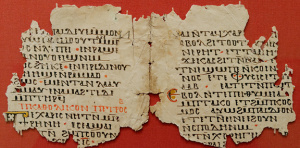Difference between revisions of "Language/Coptic/Vocabulary/Calendar"
m (Quick edit) |
(→Month) |
||
| Line 13: | Line 13: | ||
The year is made up of 12 months of 30 days and a month of 5 days (or 6 for leap years). The spelling of the months is that of the Egyptian names of the 1st millennium BC. It can be interpreted in the Latin alphabet in different ways. Here is one with in brackets the correspondence with the Gregorian calendar: | The year is made up of 12 months of 30 days and a month of 5 days (or 6 for leap years). The spelling of the months is that of the Egyptian names of the 1st millennium BC. It can be interpreted in the Latin alphabet in different ways. Here is one with in brackets the correspondence with the Gregorian calendar: | ||
# | # Thoout (September/October) | ||
# | # Paope (October/November) | ||
# | # Hathor (November/December) | ||
# | # Koiahk (December/January) | ||
# | # Tobe (January/February) | ||
# | # Meshir (February/March) | ||
# | # Paremhotep (March/April) | ||
# | # Parmoute (april/may) | ||
# | # Pashons (may/june) | ||
# | # Paone (June/July) | ||
# | # Epip (July/August) | ||
# | # Mesori (August/September) | ||
# | # The little month (from September 6 to September 10 or 11) | ||
== Leap years == | == Leap years == | ||
Revision as of 02:20, 2 September 2023
The Coptic calendar, also called the Alexandrian calendar, is the liturgical calendar of the Coptic Orthodox Church whose faithful live mainly in Egypt, in the diaspora and in Ethiopia (for which it is the calendar used on a daily basis, see Ethiopian calendar). It derives from the calendar of ancient Egypt but is no longer based on lunar cycles and includes adjustments for leap years.
The Coptic calendar also called "calendar of the martyrs" was the calendar used by the Coptic people in antiquity. It derives from the calendar of ancient Egypt but is no longer based on lunar cycles and adds facilities for leap years.
Take some time to dive into these other pages after completing this lesson: Say Hello and Greetings in Coptic, Body & People.
Functioning
The Coptic calendar finds its starting point in the year of access to power of the Roman tyrant Diocletian. This corresponds to September 11, 284 of the Gregorian calendar.
Month
The year is made up of 12 months of 30 days and a month of 5 days (or 6 for leap years). The spelling of the months is that of the Egyptian names of the 1st millennium BC. It can be interpreted in the Latin alphabet in different ways. Here is one with in brackets the correspondence with the Gregorian calendar:
- Thoout (September/October)
- Paope (October/November)
- Hathor (November/December)
- Koiahk (December/January)
- Tobe (January/February)
- Meshir (February/March)
- Paremhotep (March/April)
- Parmoute (april/may)
- Pashons (may/june)
- Paone (June/July)
- Epip (July/August)
- Mesori (August/September)
- The little month (from September 6 to September 10 or 11)
Leap years
Leap years are offset by one year with those of the Gregorian calendar. For example, the year 2000 is a leap year in the Gregorian calendar, the year before (1999) is therefore in the Coptic calendar.
Week
The Coptic week has 7 days and begins with Sunday:
- Tkyriaka: Sunday
- Pesnau: Monday
- Pshoment: Tuesday
- Peftoou: Wednesday
- Ptiou: Thursday
- Psoou: Friday
- Psabbaton: Saturday
| No. | Name | Coptic Name origin | ||
|---|---|---|---|---|
| Bohairic
Coptic |
Sahidic
Coptic |
Transliteration
of Coptic | ||
| 1 | Ⲑⲱⲟⲩⲧ | Ⲑⲟⲟⲩⲧ | Thout | ḏḥwty: Thoth, god of Wisdom and Science |
| 2 | Ⲡⲁⲟⲡⲓ | Ⲡⲁⲱⲡⲉ | Paopi | pꜣ-n-jpt: Opet Festival |
| 3 | Ⲁⲑⲱⲣ | Ϩⲁⲑⲱⲣ | Hathor | Ḥwt-ḥr: Hathor, goddess of beauty and love (the land is lush and green) |
| 4 | Ⲭⲟⲓⲁⲕ | Ⲕⲟⲓⲁϩⲕ | Koiak | kꜣ-ḥr-kꜣ: "spirit upon spirit," the name of a festival |
| 5 | Ⲧⲱⲃⲓ | Ⲧⲱⲃⲉ | Tobi | tꜣ-ꜥꜣbt: "The offering" |
| 6 | Ⲙⲉϣⲓⲣ | Ⲙϣⲓⲣ | Meshir | mḫjr: The name of a festival, perhaps identical with a type of basket used in that festival |
| 7 | Ⲡⲁⲣⲉⲙϩⲁⲧ | Ⲡⲁⲣⲙϩⲟⲧⲡ | Paremhat | pꜣ-n-jmnḥtp: "Festival of Amenhotep" |
| 8 | Ⲫⲁⲣⲙⲟⲩⲑⲓ | Ⲡⲁⲣⲙⲟⲩⲧⲉ | Parmouti | pꜣ-n-Rnnwtt: "Festival of harvest goddess Renenutet" |
| 9 | Ⲡⲁϣⲟⲛⲥ | Ⲡⲁϣⲟⲛⲥ | Pashons | pꜣ-n-ḫnsw "Festival of Khonsu" |
| 10 | Ⲡⲁⲱⲛⲓ | Ⲡⲁⲱⲛⲉ | Paoni | pꜣ-n-jnt: valley festival |
| 11 | Ⲉⲡⲓⲡ | Ⲉⲡⲏⲡ | Epip | jpjp: meaning unknown |
| 12 | Ⲙⲉⲥⲱⲣⲓ | Ⲙⲉⲥⲱⲣⲏ | Mesori | mswt rꜥ: birth of Ra |
| 13 | Ⲡⲓⲕⲟⲩϫⲓ ⲛ̀ⲁ̀ⲃⲟⲧ | Ⲉⲡⲁⲅⲟⲙⲉⲛⲁⲓ | Pi Kogi Enavot | Bohairic: The Little Month;
Sahidic: Greek ἐπαγόμεναι < ἐπαγωγή < ἐπαγειν < ἐπι + ἄγειν: to bring in |
Sources
Other Lessons
